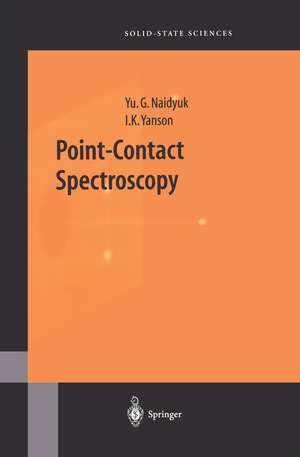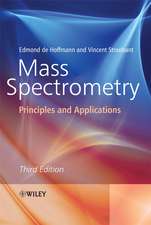Point-Contact Spectroscopy: Springer Series in Solid-State Sciences, cartea 145
Autor Yu.G. Naidyuk, I. K. Yansonen Limba Engleză Paperback – 21 sep 2011
Din seria Springer Series in Solid-State Sciences
- 18%
 Preț: 1225.94 lei
Preț: 1225.94 lei - 18%
 Preț: 1017.62 lei
Preț: 1017.62 lei - 15%
 Preț: 532.05 lei
Preț: 532.05 lei - 18%
 Preț: 944.51 lei
Preț: 944.51 lei -
 Preț: 541.47 lei
Preț: 541.47 lei - 18%
 Preț: 956.96 lei
Preț: 956.96 lei -
 Preț: 385.84 lei
Preț: 385.84 lei - 18%
 Preț: 1827.48 lei
Preț: 1827.48 lei - 15%
 Preț: 661.02 lei
Preț: 661.02 lei -
 Preț: 389.88 lei
Preț: 389.88 lei - 15%
 Preț: 639.59 lei
Preț: 639.59 lei - 15%
 Preț: 635.15 lei
Preț: 635.15 lei - 18%
 Preț: 896.21 lei
Preț: 896.21 lei - 15%
 Preț: 647.92 lei
Preț: 647.92 lei - 15%
 Preț: 651.34 lei
Preț: 651.34 lei - 18%
 Preț: 890.23 lei
Preț: 890.23 lei - 15%
 Preț: 640.55 lei
Preț: 640.55 lei - 15%
 Preț: 649.54 lei
Preț: 649.54 lei - 15%
 Preț: 645.60 lei
Preț: 645.60 lei - 15%
 Preț: 644.30 lei
Preț: 644.30 lei - 15%
 Preț: 653.79 lei
Preț: 653.79 lei - 18%
 Preț: 956.69 lei
Preț: 956.69 lei - 15%
 Preț: 637.59 lei
Preț: 637.59 lei - 23%
 Preț: 1043.42 lei
Preț: 1043.42 lei - 15%
 Preț: 639.08 lei
Preț: 639.08 lei - 15%
 Preț: 648.24 lei
Preț: 648.24 lei - 15%
 Preț: 637.46 lei
Preț: 637.46 lei - 15%
 Preț: 640.06 lei
Preț: 640.06 lei -
 Preț: 391.40 lei
Preț: 391.40 lei -
 Preț: 390.84 lei
Preț: 390.84 lei - 15%
 Preț: 638.57 lei
Preț: 638.57 lei - 18%
 Preț: 1006.06 lei
Preț: 1006.06 lei - 18%
 Preț: 730.79 lei
Preț: 730.79 lei - 15%
 Preț: 640.37 lei
Preț: 640.37 lei - 15%
 Preț: 643.65 lei
Preț: 643.65 lei - 18%
 Preț: 1231.01 lei
Preț: 1231.01 lei - 18%
 Preț: 950.21 lei
Preț: 950.21 lei - 15%
 Preț: 642.68 lei
Preț: 642.68 lei - 15%
 Preț: 640.55 lei
Preț: 640.55 lei - 18%
 Preț: 1229.10 lei
Preț: 1229.10 lei
Preț: 641.38 lei
Preț vechi: 754.56 lei
-15% Nou
Puncte Express: 962
Preț estimativ în valută:
122.73€ • 131.24$ • 102.33£
122.73€ • 131.24$ • 102.33£
Carte tipărită la comandă
Livrare economică 18 aprilie-02 mai
Preluare comenzi: 021 569.72.76
Specificații
ISBN-13: 9781441919380
ISBN-10: 1441919384
Pagini: 316
Ilustrații: XI, 297 p. 35 illus.
Dimensiuni: 155 x 235 x 22 mm
Greutate: 0.45 kg
Ediția:2005
Editura: Springer
Colecția Springer
Seria Springer Series in Solid-State Sciences
Locul publicării:New York, NY, United States
ISBN-10: 1441919384
Pagini: 316
Ilustrații: XI, 297 p. 35 illus.
Dimensiuni: 155 x 235 x 22 mm
Greutate: 0.45 kg
Ediția:2005
Editura: Springer
Colecția Springer
Seria Springer Series in Solid-State Sciences
Locul publicării:New York, NY, United States
Public țintă
ResearchCuprins
1 Introduction.- 2 Metallic point contacts as a physical tool.- 3 Fundamentals of PCS theory.- 4 Experimental techniques.- 5 PCS of quasiparticle excitations.- 6 PCS of nonphononic scattering mechanisms.- 7 Thermal effects in point contacts.- 8 Point contacts in the magnetic field.- 9 Electrical fluctuations in point contacts.- 10 Point contacts under irradiation.- 11 PCS of semimetals, semiconductors, and dielectrics.- 12 PCS of superconductors.- 13 PCS of high-Tc and other uncommon superconductors.- 14 PCS of heavy-fermion systems.- 15 New trends in research.
Notă biografică
Both authors are affiliated with the B. Verkin Institute for Low Temperatire Physics and Engineering, National Academy of Sciences of Ukraine.
Textul de pe ultima copertă
A new type of spectroscopy, Point-Contact Spectroscopy, was created for the study of conduction electron interaction mechanism with a class of elementary excitations in solids. The goal of this book is to introduce readers to Point Contact Spectroscopy.
The physical principles of spectroscopy of quasi-particle excitations in metals at low temperatures by means of point contacts are presented. The point contact constitutes a tiny metallic bridge connecting bulk electrodes. Along with the most thoroughly studied phonon excitations, the interaction of electrons with other quasiparticles (magnons, crystal-field electron excitations, paramagnetic impurities, two-level systems, etc), are reviewed.
Various experimental techniques for point contact production are described. Examples of point-contact spectra are presented for pure metals, alloys and compounds, as well as for semimetals and semiconductors, high-Tc and other exotic superconductors, heavy fermion systems, Kondo-lattices, mixed valence compounds and more. Special attention is paid to contact conductance behavior in superconducting states, in high magnetic fields and under high-frequency radiation. The theoretical part of the book is restricted to presenting the main relations without superfluous details.
Point-Contact Spectroscopy includes more than 200 figures.
The physical principles of spectroscopy of quasi-particle excitations in metals at low temperatures by means of point contacts are presented. The point contact constitutes a tiny metallic bridge connecting bulk electrodes. Along with the most thoroughly studied phonon excitations, the interaction of electrons with other quasiparticles (magnons, crystal-field electron excitations, paramagnetic impurities, two-level systems, etc), are reviewed.
Various experimental techniques for point contact production are described. Examples of point-contact spectra are presented for pure metals, alloys and compounds, as well as for semimetals and semiconductors, high-Tc and other exotic superconductors, heavy fermion systems, Kondo-lattices, mixed valence compounds and more. Special attention is paid to contact conductance behavior in superconducting states, in high magnetic fields and under high-frequency radiation. The theoretical part of the book is restricted to presenting the main relations without superfluous details.
Point-Contact Spectroscopy includes more than 200 figures.
Caracteristici
Describes various experimental techniques for point contact production Presents examples of point-contact spectra for pure metals, alloys and compounds, as well as for semimetals and semiconductors, heavy fermion systems, Kond-lattices, mixed valence compounds and more Considers superconducting point contacts in respect to Andreev reflection and Josephson effects Pays special attention to contact conductance fluctuation, and outlines new trends of research Includes supplementary material: sn.pub/extras








